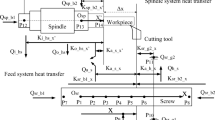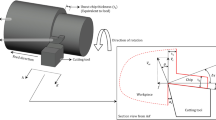Abstract
Among the errors in precision machining, thermal error has been recognized as the most significant error. The heat of the nut in the feed drive system plays an important role in the thermal error generated by the feed drive system. To better estimate and further understand the increase in temperature and thermal deformation of the ball screw during operation, a new correlation equation for the frictional torque of the nut is proposed and determined in this study for the calculation of the frictional torque of the nut and the heat generated by the nut at different feed velocities and nut temperatures. In this study, a set of devices for measuring the frictional torque of the nut under different feed velocities and different nut temperatures is designed and established. Various experimental conditions are designed to measure the frictional torque of the nut at different feed velocities and different nut temperatures to establish a correlation equation for the frictional torque of the nut. In addition, for further confirmation, the method for measuring the frictional torque of the nut used in this study is compared with the method using a handheld digital force gauge. The correlation equation for the frictional torque of the nut established in this study is based on the LuGre model and the formula of the frictional torque due to the viscosity of the lubricant of the bearing at different temperatures. The results show that the root-mean-square error between the frictional torque of the nut calculated by the correlation equation and that measured experimentally is 0.0301 N-m, indicating that the correlation equation for the frictional torque of the nut proposed in this study is accurate and feasible.












Similar content being viewed by others
Change history
01 February 2021
During the correction process unfortunately the author photos in the biography section have been interchanged. The correction biographies should be as follows.
References
Xu, Z. Z., Liu, X. J., Choi, C. H., & Lyu, S. K. (2012). A study on improvement of ball screw system positioning error with liquid-cooling. Int J Precis Eng Manuf, 13, 2173–2181.
Xu, Z. Z., Liu, X. J., Kim, H. K., Shin, J. H., & Lyu, S. K. (2011). Thermal error forecast and performance evaluation for an air-cooling ball screw system. International Journal of Machine Tools and Manufacture, 51, 605–611.
Ahn, J. Y., & Chung, S. C. (2004). Real-time estimation of the temperature distribution and expansion of a ball screw system using an observer. Proc Institution Mech Eng Part B-J Eng Manuf, 218, 1667–1681.
Verl, A., & Frey, S. (2010). Correlation between feed velocity and preloading in ball screw drives. CIRP annals, 59, 429–432.
Corporation, H. (2019). Hiwin Ballscrews Technical Information. Taiwan: Hiwin Corporation.
Zhou, C.-G., Feng, H.-T., Chen, Z.-T., & Ou, Y. (2016). Correlation between preload and no-load drag torque of ball screws. International Journal of Machine Tools and Manufacture, 102, 35–40.
NSK Ltd., (2019) Precision machine components, NSK Ltd., Tokyo.
R. H. R Tian, “Solution for heating of ball screw and environmental engineering,” World Manufacturing Engineering and Market, 2004.
Xu, Z. Z., Liu, X. J., & Lyu, S. K. (2014). Study on positioning accuracy of nut/shaft air cooling ball screw for high-precision feed drive. Int J Precis Eng Manuf, 15, 111–116.
Xu, Z.-Z., Choi, C., Liang, L.-J., Li, D.-Y., & Lyu, S.-K. (2015). Study on a novel thermal error compensation system for high-precision ball screw feed drive (1st report: model, calculation and simulation). Int J Precis Eng Manuf, 16, 2005–2011.
B. X. Liu and S. H. Nie (2015), “Dynamic Parameters Identification of LuGre Friction Model Based on Chain Code Technique,” Proceedings of the 14th IFToMM World Congress, pp. 216–222,.
Åström, K. J., & Canudas de Wit, C. (2008). Revisiting the LuGre friction model. IEEE Control Systems Magazine, 28(6), 101–114.
Do, N. B., Ferri, A. A., & Bauchau, O. A. (2007). Efficient Simulation of a Dynamic System with LuGre Friction. Journal of Computational and Nonlinear Dynamics, 2, 281–289.
De Wit, C. C., Olsson, H., Astrom, K. J., & Lischinsky, P. (1995). A new model for control of systems with friction. IEEE Trans automatic control, 40, 419–425.
Jin, C., Wu, B., & Hu, Y. M. (2012). Heat generation modeling of ball bearing based on internal load distribution. Tribology Int, 45, 8–15.
Min, X., Shuyun, J., & Ying, C. (2007). An improved thermal model for machine tool bearings. International Journal of Machine Tools and Manufacture, 47, 53–62.
Wang, C.-R., Liu, D.-S., Huang, C.-H., & Shiau, T.-N. (2016). Numerical investigation into dynamic behavior of adjustable preload double-nut ball screw. J Mech Sci Tech, 30, 4489–4496.
Miller, J., & Miller, J. (1988). Statistics for analytical chemistry (2nd ed.). United States: Halsted Press.
Gunduz, A., & Singh, R. (2013). Stiffness matrix formulation for double row angular contact ball bearings: analytical development and validation. J Sound and Vib, 332, 5898–5916.
https://www.andilog.com/digital-force-gauge-force-tester-centor-series.html. Accessed on: Aug.10, 2020
Armstrong-Hélouvry, B., Dupont, P., & De Wit, C. C. (1994). A survey of models, analysis tools and compensation methods for the control of machines with friction. Automatica, 30, 1083–1138.
Acknowledgements
This work represents part of the results obtained under contract no. MOST 106-2622-E-194 -003 -CC2 sponsored by the Ministry of Science and Technology (MOST), Taiwan, ROC.
Author information
Authors and Affiliations
Corresponding author
Additional information
Publisher's Note
Springer Nature remains neutral with regard to jurisdictional claims in published maps and institutional affiliations.
The original online version of this article was revised: during the correction process unfortunately the author photos in the biography section have been interchanged.
Rights and permissions
About this article
Cite this article
Kuo, TC., Hwang, YC. & Hsieh, WH. A New Correlation Equation for Calculating the Frictional Torque of the Nut at Different Feed Velocities and Nut Temperatures. Int. J. Precis. Eng. Manuf. 22, 41–50 (2021). https://doi.org/10.1007/s12541-020-00448-z
Received:
Revised:
Accepted:
Published:
Issue Date:
DOI: https://doi.org/10.1007/s12541-020-00448-z




